Rafal Lukawiecki
Member
To all film chart junkiesI'm limited in terms of my sensitometer (see my other (there was a url link here which no longer exists) on the subject) and having read positive feedback from Dale's (there was a url link here which no longer exists), I have just employed it for this test of Delta 100, a film I am somewhat new to.
After doing a quick test, I established that the native exposure of SL-2 wastes about 3-4 strips (SL-2 uses a 21-step tablet) on this film. In order to get useful higher-density data without wasting too many underexposed strips, I have given each sheet precisely 2 consecutive exposures with the green, and separately, 2 exposures with the blue light. The green is short-duration, sounds like 1/4s, blue is longer, about 1 sec, so it means one strip received about 1/2s the other about 2s, so possibly in reciprocity failure, except Delta is supposedly well behaved in that region.
I have compiled, for you, three sets of charts (using my new curve/CI calculator, (there was a url link here which no longer exists) if you want to use it). One for just the green exposure (seems touch more contrasty), one for the blue (slightly softer), and then a third one, being a simple mean of the two. It seems my N dev time needs to be a bit shorter than Ilford recommendation (8 min vs. 12), which does not surprise me too much, as I aim for a slightly softer negative (CI about 0.58 as opposed to a more common 0.62, worth about a minute) and I tend to agitate more than typically demanded. I will be using the results of my tests for my next batch of real negatives, but I wonder if the curves look at all reasonable to anyone who has experienced this film in this developer.
Curves:
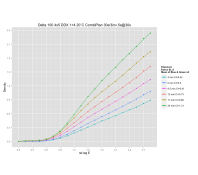
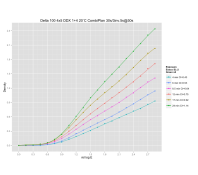
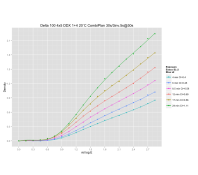
Development Time vs CI/N:
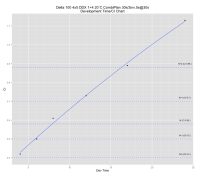
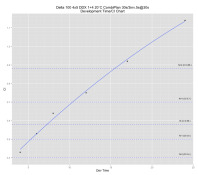

I do wonder how far those contrasts are from a red exposure. One day, I hope I can get my hands on a white-light sensitometer. Anyone wants to get rid of their EG&G?
After doing a quick test, I established that the native exposure of SL-2 wastes about 3-4 strips (SL-2 uses a 21-step tablet) on this film. In order to get useful higher-density data without wasting too many underexposed strips, I have given each sheet precisely 2 consecutive exposures with the green, and separately, 2 exposures with the blue light. The green is short-duration, sounds like 1/4s, blue is longer, about 1 sec, so it means one strip received about 1/2s the other about 2s, so possibly in reciprocity failure, except Delta is supposedly well behaved in that region.
I have compiled, for you, three sets of charts (using my new curve/CI calculator, (there was a url link here which no longer exists) if you want to use it). One for just the green exposure (seems touch more contrasty), one for the blue (slightly softer), and then a third one, being a simple mean of the two. It seems my N dev time needs to be a bit shorter than Ilford recommendation (8 min vs. 12), which does not surprise me too much, as I aim for a slightly softer negative (CI about 0.58 as opposed to a more common 0.62, worth about a minute) and I tend to agitate more than typically demanded. I will be using the results of my tests for my next batch of real negatives, but I wonder if the curves look at all reasonable to anyone who has experienced this film in this developer.
Curves:



Development Time vs CI/N:



I do wonder how far those contrasts are from a red exposure. One day, I hope I can get my hands on a white-light sensitometer. Anyone wants to get rid of their EG&G?












